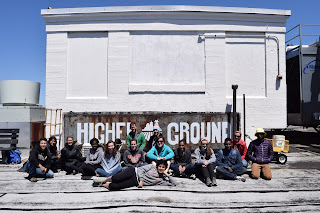For breakfast, our main staple items were english muffins, oatmeal, and fruits such as apples or bananas. Coffee, tea, and orange juice was also available! These options seems to work well for everyone and easy to prepare on to go. One morning we did have pancakes (with a vegan option!) with sliced fruit and syrup. For the second half of the week, we had strawberries and watermelon too! So yummy.
For lunch, the team had two options: plain PB &J on bread or veggie wrap with hummus. We purchased veggies like carrots, cucumber, celery, and salad mix! It was such a huge hit and fairly inexpensive when buying veggies in bulk. Snacks included applesauce, grapes, chips, and a number of small goodies on sale! Dinner leftovers were also a close favorite and packed for many lunches in the vans. I think you'll see why..
For dinner, we wanted to select recipes that were relatively easy to make, inexpensive, and could accommodate all of our dietary restrictions. Our team also agreed to go completely vegetarian all week and forego meat to keep with AB's motto of living simply. Here are some of our favorite dinner meals from the week:
 |
| Veggie Soup with a side of Seasoned Potatoes Recipe Inspiration: http://www.cookingclassy.com/2014/10/vegetable-soup/ |
 |
| Sassy Quinoa, a definitely crowd pleaser! Recipe Inspiration: http://traceysculinaryadventures.com/2014/01/one-pot-mexican-quinoa-2.html |
 |
| Veggie Burritos Recipe Inspiration: http://www.foodandwine.com/recipes/black-bean-and-roasted-vegetable-burritos |
 |
| Veggie Curry with Rice and Side Salad Recipe Inspiration: http://thestonesoup.com/blog/2013/01/my-dirty-little-secret/ |
**The term "Recipe Inspiration" was used because we had to tweak the recipes depending on what we had available in the kitchen!**
Every night, a number of people offered to help prepare dinner in the kitchen. After a long day of service, it was amazing to see our group jumping right into the kitchen, slicing veggies, mixing up sweet tea or lemonade, and setting the table. A sweet aroma always lingered from the kitchen in the evenings, making our bellies growl even more, and the meals were absolutely delicious.
And our meal planning did not exclude dessert! While we did have some ice cream, brownies, and smores, we also had some unique dishes to satisfy our sweet cravings. Our experience wouldn't have been the same without this dessert, so I must highlight it!
And our meal planning did not exclude dessert! While we did have some ice cream, brownies, and smores, we also had some unique dishes to satisfy our sweet cravings. Our experience wouldn't have been the same without this dessert, so I must highlight it!
 |
| Fruit Cake with Raspberries, Strawberries, Blueberries, Pineapple, and Kiwi! Thanks to everyone who helped make this possible. :) |
Being an AB trip surrounding fresh food, it was essential that we incorporated it into all of our meals. We made a tremendous effort to avoid overly processed foods and instead purchase fresh, organic, and local options. Our group was fortunate that a Whole Foods was located just minutes away in downtown Andover and we challenged teams to find a list of items for our remaining meals, keeping it under a certain budget. Despite some setbacks and upsets, I believe it was an incredible learning experience to truly think about what we are putting into our mouths. Where did it come from? Does it contain any ingredients I am unsure of? Does it contain any nuts or dairy products? These were all questions we had to think over before making a decision. Our choices as consumers have a direct impact on the producers of those products. What are we actually supporting? Food for thought.
- Karyn Owens, Experience Leader
- Karyn Owens, Experience Leader












